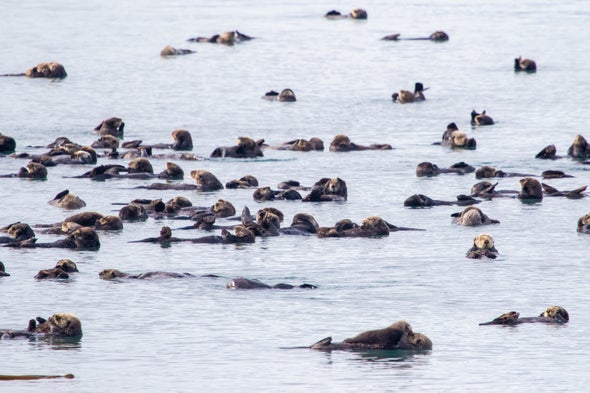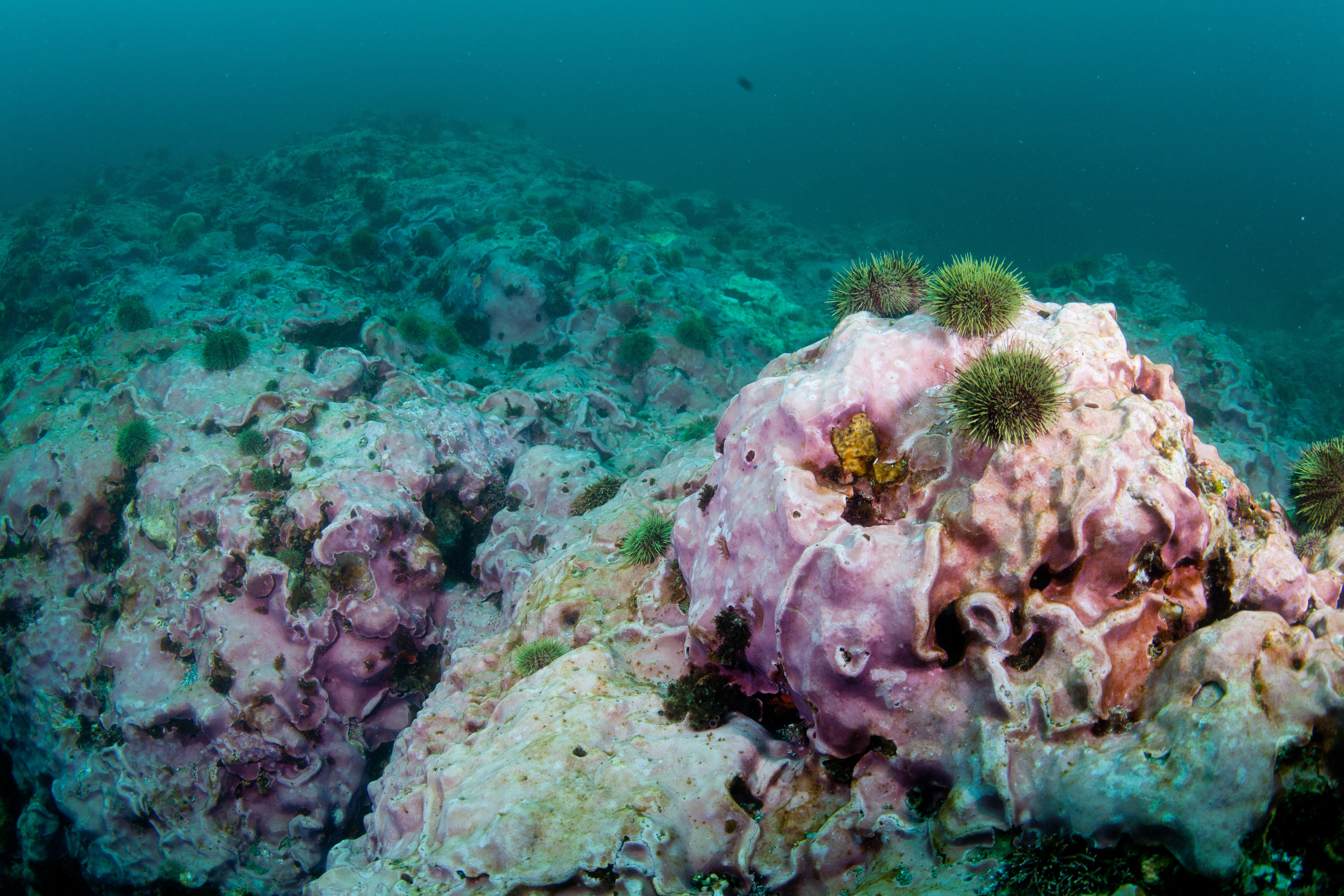
While scuba diving around the Aleutian Islands in 2014, marine ecologist Doug Rasher saw little sign of the curtains of lush green kelp forests he would have had to push through decades earlier. “It feels like a ghost town,” says Rasher, a researcher at the nonprofit Bigelow Laboratory for Ocean Sciences. The eeriness did not end there: during a boat ride, one of Rasher’s colleagues pointed to a cove where he had seen hundreds of sea otters splashing in the frigid water in the 1970s. Only a handful remained.
The two losses are connected. As sea otters declined (for reasons scientists are still trying to understand), their favorite prey—sea urchins—exploded in number. The voracious echinoderms not only mowed down the kelp but are also tearing apart and devouring the massive, slow-forming limestone reefs on which this seaweed grows, Rasher and his colleagues recently reported in Science. Rising ocean temperatures and acidification are compounding the damage.
Restoring otter populations could rein in the urchins and help protect the larger ecosystem, and ecologists are increasingly interested in applying this idea more broadly. “Our study ... highlights the power of trophic cascades in nature and the potential for large predators to ameliorate some of the effects of climate change in the near term,” Rasher and his co-authors wrote. (“Trophic cascade” refers to the compounding effects of removing an organism from an ecosystem.) Many climate impact studies on species have not adequately acknowledged this kind of ecosystem complexity as a factor, according to Rasher and other scientists. Incorporating it would offer a clearer picture of what a warmer future holds in store. “I think we’re all coming to realize that there’s going to be a lot of synergies between species loss and climate change,” says Hillary Young, an ecologist at the University of California, Santa Barbara, who was not involved in the new study. “So what you would expect to happen with the loss of a species in the absence of climate change is not what’s going to happen with the loss of that species in the presence of climate change .... And this paper is the holy grail of showing that interaction.”
The idea of restoring predators to blunt the impacts of warming has been simmering in ecology for decades. Fifteen years ago Christopher Wilmers, a wildlife ecologist now at the University of California, Santa Cruz, published studies looking at how warmer winters in Yellowstone National Park meant fewer elk foundering in deep snow and dying. The result was less early-winter carrion for the park’s many scavengers, such as grizzly bears and ravens, with dead elk bunching up at the end of relatively severe winters. After wolves were reintroduced in 1995, though, they became the main cause of elk mortality and created a steadier carrion supply that helped sustain other animals throughout the cold months. “Wolves provide this kind of temporal subsidy, where they’re making food for scavengers that would be overabundant at one time of year and underabundant at another and smoothing it out,” says Wilmers, who tracked Yellowstone wolf packs for four years.

Volker Rudolf, an ecologist at Rice University, also found that predators can alter the effects of climate change. In a 2018 study he considered how interactions among pond predators (dragonfly larvae) and their herbivorous prey (the tadpoles of gray tree frogs and green frogs) changed amid rising temperatures.
Rudolf created four habitats with pond water at present-day temperatures and four with heated pond water. He raised some tadpoles separated by species, some with mixed species, and others with mixed species and the dragonfly larvae. One species had lower survival rates in heated water when it was on its own—but when exposed to either competition or predation, the rates between heated and nonheated ponds were virtually equal. It could be that warmer conditions slow the larvae’s metabolism, prompting the predators to eat less, Rudolf says. Or the tadpoles might grow so fast in warmer water that it is harder for the larvae to capture them. “You might have reduced survival because of the direct effect of heat,” he says, “but [changes caused by] predation and competition can compensate for those direct losses. It buffers it out a bit.”
Rudolf, Wilmers and Rasher all say their work shows that future climate change research needs to factor in ecosystem complexity more effectively. For instance, many scientists have studied how climate change will affect marine organisms’ performance and survival. They have mostly done so by exposing a single species to warmer temperatures and/or higher acidity and recording how it responds, however. Such work is valuable but can miss the big picture if it ignores the community in which a species exists. “Everything we know about ecology is that as things get more complex, they change,” Rudolf says. That perspective is echoed in a soon to be published paper by University of Colorado Boulder ecologist Laura Dee, who points to the many indirect effects warmer temperatures can have on a species. These include increasing or decreasing prey, changing competitive abilities, shifting feeding rates and altering trophic cascades.
In the case of the Aleutian Islands’ reefs, for example, if the scientists had simply exposed living reef samples to warmer and more acidic water in the lab, they might have incorrectly concluded the reefs were in no great danger because those impacts alone only slightly softened their skeleton. But because the researchers also included sea urchins in their tanks, they realized how the two forces interacted: sea urchin grazing increased significantly as warming and acidity increased, pushing the system “beyond a critical tipping point,” Rasher says.
In 2017 his team resurveyed the reefs’ status across the Aleutian archipelago and discovered that some had shrunk precipitously in just three years. Large areas that had been alive for centuries or millennia were crumbling and bleached, indicating urchins had recently killed them. Such devastation underscores the urgency of restoring balance to the ecosystem by bringing the otters back. And similar situations likely hold true for other ecosystems across the globe. Scientists still need to understand the reasons behind the otters’ disappearances, but Rasher Is hopeful. “Bringing the otters back would bring many ecological benefits,” he says, “and would also buy us time to get our act together on curbing carbon emissions.”
"can" - Google News
November 18, 2020 at 06:49PM
https://ift.tt/32SVqLc
Otters Show How Predators Can Blunt Climate Damage - Scientific American
"can" - Google News
https://ift.tt/2NE2i6G
https://ift.tt/3d3vX4n
Bagikan Berita Ini














0 Response to "Otters Show How Predators Can Blunt Climate Damage - Scientific American"
Post a Comment